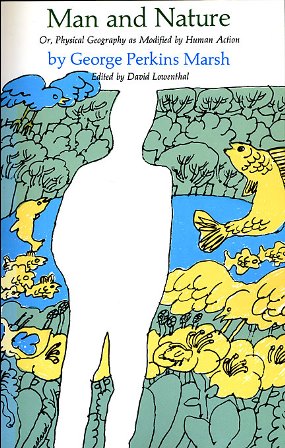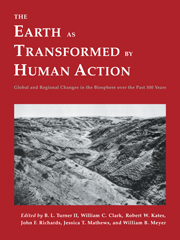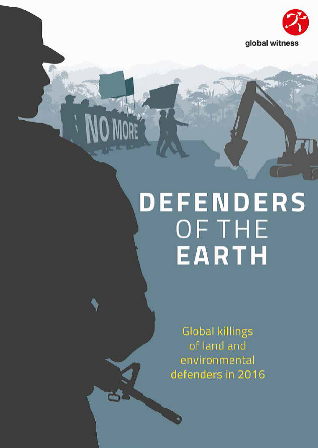My memory is of worry, hope, and anger. There was remarkable scholarship too, but there was no escaping the sense that this scholarship came bundled with feelings. It was late 1987, and the Earth as Transformed by Human Action conference (highlighted in the retrospective to this series as “the most acclaimed” of earlier SSRC-supported efforts to develop knowledge on global environmental change) had brought some stellar biophysical and social scientists to the Graduate School of Geography at Clark University to think collectively about what the world was doing to the world, to document these impacts, and to conceptualize them. (I was a grad student RA involved in the event.) Earth as Transformed claimed that the human imprint on the planet had moved on from the modified landscapes long ago described by George Perkins Marsh,1 1864; repr., Cambridge, MA: Belknap Press of Harvard University Press, 1965More Info → to the wholesale transformation of global biogeochemical flows and entire land-cover faces and biota, such that the Earth system as an entity was being irredeemably changed. This was the worry—the sense of the world embarking on an unprecedented journey with no map.
1864; repr., Cambridge, MA: Belknap Press of Harvard University Press, 1965More Info → to the wholesale transformation of global biogeochemical flows and entire land-cover faces and biota, such that the Earth system as an entity was being irredeemably changed. This was the worry—the sense of the world embarking on an unprecedented journey with no map.
Simplifying dramatically, Earth as Transformed understood the Earth system as an ongoing interaction among global flows (of chemicals, water, people, goods…), faces (forests, plains, oceans…), culturally constructed regions (“Amazonia,” “Caucasia,” “Sweden”…), human drivers of change (technology, urbanization, population…), and background “natural” planetary change. These drivers were changing the faces of the earth and altering the ways in which flows of water, carbon, nitrogen, phosphorous, pollutants, and more coursed through regions, ecosystems, and bodies. The 1987 conference and resulting book2 Cambridge: Cambridge University Press, 1990More Info → were an effort to show that these processes and interactions could be documented systematically, often quantitatively, and could only be understood through a combination of biophysical and social science. The message was that biophysical and social systems were inherently coupled, and that any global change research agenda had to build from an awareness of this coupling. In this conceptualization, the outline of a discipline later called sustainability science was being framed and justified. This was the hope.
Cambridge: Cambridge University Press, 1990More Info → were an effort to show that these processes and interactions could be documented systematically, often quantitatively, and could only be understood through a combination of biophysical and social science. The message was that biophysical and social systems were inherently coupled, and that any global change research agenda had to build from an awareness of this coupling. In this conceptualization, the outline of a discipline later called sustainability science was being framed and justified. This was the hope.
Conspicuous by their almost complete absence at the conference were discussions of justice, race, class, ethnicity, power, or political economy. Beyond Carolyn Merchant’s paper on gender and environmental transformations, a passionate intervention from Michael Watts on the politics of the drivers and transformations being discussed, and a culturally inflected discussion of institutions from John Bennett and Kenneth Dahlberg, themes that might normally be at the core of an environmental justice agenda were missing in action. One would struggle to find the term justice in the resulting book. Yet how would a theorization of global change adequately account for its drivers or its socially differentiated consequences without engaging with these concerns? These absences were not accidental, or so it seemed to a young RA. They derived from a concern that the languages of social theory and activist politics would aggravate divides among biophysical scientists and social scientists. If the purpose was to engage the wider scientific community and change scientific agendas for global change research, then the language of contentious politics could undermine the enterprise, or so the thinking appeared to go. This was the origin of the anger: some angry at a perceived exclusion of certain concepts and theory, others annoyed at languages seen as divisive.
Scientific and justice agendas
In the subsequent three decades, scientific agendas have changed; but the transformation of the earth did not slow down. The injustices and asymmetries that global change produces, and that help drive global change, continued and in many instances got worse. Thirty years after the Earth as Transformed conference, Global Witness published Defenders of the Earth,3 Global Witness, July 13, 2017More Info → reporting the killings of 200 environmental defenders worldwide in 2016, a “record,” up from 185 reported killings the previous year, another “record.” These are just the killings Global Witness could track down—presumably there are others not recorded, as well as many more people who are threatened and intimidated because of their role resisting socio-environmental injustices in communities, through social movements, and with civil society organizations.
Global Witness, July 13, 2017More Info → reporting the killings of 200 environmental defenders worldwide in 2016, a “record,” up from 185 reported killings the previous year, another “record.” These are just the killings Global Witness could track down—presumably there are others not recorded, as well as many more people who are threatened and intimidated because of their role resisting socio-environmental injustices in communities, through social movements, and with civil society organizations.
Year-on-year environmental violence tracks with year-on-year global temperatures: upwards. “This tide of violence is driven by an intensifying fight for land and natural resources, as mining, logging, hydro-electric and agricultural companies trample on people and the environment in their pursuit of profit,” according to Global Witness.4Defenders of the Earth, 6. It is too simple to say that environmental defenders are killed and persecuted because they are motivated to respond to earth transformations. But they are defending what Earth as Transformed called faces and regions, even if these defenders may be more likely to speak of territories and livelihoods. Though motivated by livelihood, rights, and indignation, they are at the same time contesting processes that will lead to increased greenhouse gases through the clearing of forest, the mining of coal, and the extraction of dirty oil—emissions that further transform the deeply altered biogeochemical flows documented in Earth as Transformed.
“Global Witness is documenting an empirical phenomenon absent from Earth as Transformed, yet entirely relevant to the concerns global environmental change.”When publishing Defenders of the Earth, Global Witness had, I presume, no particular interest in talking to the theoretical concerns of global environmental change scholars. Global Witness is not involved in academic environmental justice scholarship. It is an NGO conducting advocacy and activism around the “links between demand for natural resources, corruption, armed conflict and environmental destruction.” Defenders of the Earth is part of this work and seeks to draw attention to human rights abuses related to natural resource extraction. It is a quite different project from Earth as Transformed, with different goals. But Global Witness is documenting an empirical phenomenon absent from Earth as Transformed, yet entirely relevant to the concerns global environmental change. For that reason, there is a conversation to be had between these two endeavors.
The message from Defenders of the Earth is that any adequate theory of global environmental change of the sort Earth as Transformed was seeking cannot sidestep environmental justice activism. It must instead understand and conceptualize environmental defenders from within that theory. If these defenders are what stand between the drivers of earth transformation and the transformation itself, then they are endogenous to the issue being theorized. An adequate theory of global environmental change also has to explain the incentives and motivations that lead to the targeting, killing, and intimidation of those resisting earth transformation, because what produces those incentives itself propels earth transformation.
Meanwhile, Earth as Transformed also has some things to say to environmental justice (EJ) scholarship. While its 720 pages may suggest otherwise, the book was an exercise in simplification. Scholars summarized 300 years of environmental transformation in 15–20 pages, using reasonably comparable metrics with a view to telling an aggregate story in ways that might convince readers. In some way, Defenders of the Earth engages in a similar simplification and aggregation in order to convey a powerful message. Might EJ scholarship make use of such strategies, at least sometimes? Another implication is that theorizations of resistance and of “just environments” may be stopping short if they do not connect defense of livelihood, rights, and the lived environment to its impact on regional and global biogeochemical flows and changes in biota. How does such defense interact with other drivers of earth transformation, and under what conditions might it blunt the voracity of such drivers? Surely there are wider, and global, ecological consequences of socio-environmental defense, and tracing these effects along with the implications for the rights and livelihoods of those doing the defending might broaden the significance and purchase of the justice agenda and show how it can be connected to global change theory. Finally, as shown by several regional studies in Earth as Transformed, not all local resource users are environmental stewards; they have also overused, degraded, and transformed ecologies in ways that disadvantage neighbors and subsequent generations. The implication is that while environmental defenders may often be motivated by stewardship, they can also be driven by the desire to profit from resource extraction themselves rather than ceding the power to accumulate to external actors.
Finding common ground
“I would suggest the work of many global environmental change scientists is as appropriately characterized as resistance as is the work of EJ scholars.”For me at least, the juxtaposition of the “Just Environments” series and the Council’s earlier Global Environmental Change program, or of Defenders of the Earth and Earth as Transformed, speaks of the continuing value in bridging scholarly and other communities with different traditions of analysis and engagement. Indeed, I would suggest the work of many global environmental change scientists is as appropriately characterized as resistance as is the work of EJ scholars. There is a reason scientists are vilified by interest groups and have their emails sequestered as a result of politically motivated legal and Freedom of Information interventions. Yet broader articulations of these forms of resistance remain fragmented, even when agendas overlap. Maybe this is because justice writing keeps its distance from what it perceives as the scientism and technocratic motivation underlying global environmental change, resilience, and modeling work. Maybe it is because global environmental change scientists get frustrated with social theories of nature that leave too much unverifiable and that struggle to agree on shared agendas for action. Maybe it is because conservation-minded organizations step back from addressing the human rights consequences of (for instance) coal, oil, or mining, because they worry that they will be cast as antidevelopment, asked to leave the countries in which they are working, and left unable to continue the more reform-minded or hidden aspects of their environmental change work.
These are all understandable, legitimate concerns; but some organizations succeed in navigating them and engaging in both the global environmental change and EJ agendas (think of the Rights and Resources Initiative, World Resources Institute, and International Institute of Environment and Development). There are ways of working, compromising, and communicating through which these constituencies can find overlapping languages to address shared concerns through joint agendas. What at least seems clear is that languages and articulations to date have been insufficient: there can be no other way to interpret the fact that deaths, injustices, temperature, and forest loss continue to track upwards together.
There are different ways in which programs could help the global change and environmental justice communities collaborate. I close suggesting one of these: the challenge of aggregating analysis across locations and scales. This is a recurrent problem in climate change models: how to make global models work for national or subnational projections, or how to build from regional to global analysis. Earth as Transformed also posed this problem by talking of flows, faces, and regions, but failed to integrate its analyses across these levels. This weakness undermines the political valence of global change science. Similar challenges haunt environmental justice work. In the same way that there is no such thing as “just” the environment, there is no “just environment” that is “just” for everyone; and often the justice agendas of different groups would lead to quite different types of environmental transformation. For instance, as Bolivia moves to extract more and more hydrocarbons from indigenous territories or protected areas, injustices are evidently being committed—consultation is compromised; territorial claims are overridden; environmental damage is delivered, all in ways that are differentiated by gender and relative wealth.5See, for example, the work by Almut Schilling Vacaflor and Denise Humphreys Bebbington on who does and does not have voice in such consultations and negotiations. But there can be little doubt that the social programs resourced by revenue from hydrocarbons have significantly reduced poverty. As South Africa extracts coal from a stunningly transformed Mpumulanga, the implications for human health and water quality in neighboring communities are dramatic. As Indonesia moves to expand coal extraction from the primary forests of Kalimantan, the impacts on greenhouse gas emissions and community rights are palpable. But in each country, in addition to releasing CO2, some of this coal also produces or will produce electricity for grossly underserved people who suffer chronic injustices of energy access. And then there is the issue of squaring employment, health, water, and carbon agendas in discussions around US coal. These different dilemmas are products of prior injustices and exclusions, and most of the benefits of the accumulation made possible by natural resource extraction are enjoyed well beyond these underserved communities.
What remains to be addressed
It remains essential to document these violent histories: a politics of justice will always be in part a politics of memory and historical wrongs. But the analytical and political challenge remains: What does producing just environments both for those who are affected by extraction and for those urban populations who are excluded from adequate energy access look like? What does the joint agenda of national and local (and global) socio-environmental justice look like? Producing a vision and possible course of action for the future is not the same as indulging the often-criticized question of “Tell us what to do.” But the task of at least pointing forward, of defining what might be doable by and with whole networks of communities exposed to environmental and other injustices, and of crafting agendas that are coherent across scales remains. It is as politically urgent as it is analytically necessary.
“The challenge exceeds social science and the humanities, and it also exceeds the academy.”If global environmental change continues at current rates, securing the justice agendas of people living in particular communities and particular places will be so much harder. Climate change can only lead further along that graph in which environmental violence and global warming track together, relentlessly upwards. Likewise, if environmental defenders continue to be silenced, intimidated, and killed, then earth transformations will continue and no amount of advocacy by sustainability scientists and IPCC authors will make a difference. The global transformations documented by the Earth as Transformed conference in 1987 will seem like a Peter Rabbit story by comparison. Producing just environments demands work across scholarly inquiry, across scales, and across places—just places, just Earth. The challenge exceeds social science and the humanities, and it also exceeds the academy. This takes us back to the scientists and social scientists gathered at Clark University in 1987, seeking to build knowledge together. This time around, however, the enterprise would have to recognize that earth transformation is a justice agenda; that justice is an earth transformation agenda; that scholarly, technocratic, and activist agendas overlap; and that it is among these overlaps that pathways to a more just, less transformed earth are most likely found.
I am grateful to Jon Barnett, Simon Batterbury, Wolfram Dressler, Vanessa Lamb, Lisa Palmer, and Bill Turner for their comments. I also acknowledge the generous support of an Australia Laureate Fellowship supported by the Australian Research Council.













